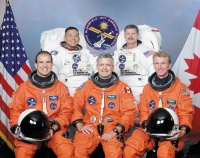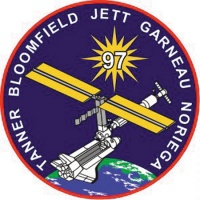STS-97
From The Space Library
 | |
| Organization | NASA-Office of Space Flight (United States) |
|---|---|
| Mission type | Engineering,Human Crew |
| Launch date | December 1, 2000 |
| Launch vehicle | Space Shuttle |
| Launch site | Cape Canaveral, United States |
| COSPAR ID | 2000-078A |
| Inclination | 51.6 degrees |
| Experiments | Here |
| Alternate Names | 26630 |
| Additional Information | Here |
| Data Collection | Here |
| Payload Mass Up | 17007.9 kg |
| Payload Mass Down | 872.73 kg |
| Orbiter | Endeavour |
| Lift Off Mass | 2,056,725.00 kg |
| Orbiter Weight at Liftoff | 121,168.18 kg |
| Orbiter Weight at Landing | 89,716.82 kg |
| Landed | Concrete runway 15 at Kennedy Space Center, Fla. |
| Orbits of Earth | 170 |
| Orbital Altitude | 205 nautical miles |
Contents |
[edit] Crew
- Commander: Brent W. Jett Jr.
- Pilot: Michael J. Bloomfield
- Payload Commander:
- Mission Specialist 1: Marc Garneau, Canadian Space Agency
- Mission Specialist 2: Joseph R. Tanner
- Mission Specialist 3: Carlos I. Noriega
- Mission Specialist 4:
- Mission Specialist 5:
- Payload Specialist 1:
- Payload Specialist 2:
ISS/Mir Crew Transport
[edit] Mission
STS 97 is an American shuttle spacecraft that was launched from Cape Canaveral at 03:06 UT. The main mission was to install a 72 m x 11.4 m, 65 kW double-wing solar panel on the UNITY module of the International Space Station (ISS). Including the support beams, radiators and batteries, the power generator has a mass of 15.75 tons. The previously docked Progress-M1 4 cargo spacecraft had to be temporarily evicted from the ISS before the installation. It required several spacewalks by the crew to extend the panel taut enough. The shuttle landed back in Cape Canaveral at 23:03 UT on 11 December.
[edit] EVA
Extravehicular Activity (EVA) conducted by Joseph Tanner and Carlos Noriega during three spacewalks for a total of 19 hours, 20 minutes. EVA 1, Tanner and Noriega, 7 hours, 33 minutes; Tanner and Noriega attached the P6 integrated truss structure to the Z1 truss, prepared the solar arrays for deployment, and prepared the radiator for power system deployment. EVA 2, Tanner and Noriega, 6 hours, 37 minutes; Tanner and Noriega configured the ISS for use of the power from the P6, positioned the S-band for use by the space station, and prepared the ISS for the arrival of the U.S. Laboratory on mission ISS-5A. EVA 3, Tanner and Noriega, 5 hours, 10 minutes; Tanner and Noriega performed repair work to increase tension in the starboard solar array blankets and performed get-ahead tasks that were planned for future space station assembly missions.
[edit] Payload
International Space Station (4A); P6 photovoltaic array assembly; integrated equipment assembly
[edit] Books about the Space Shuttle Program
Buy This Book Click here |
Buy This Book here |
Buy This Book Click here |
Buy This Book Click here |





